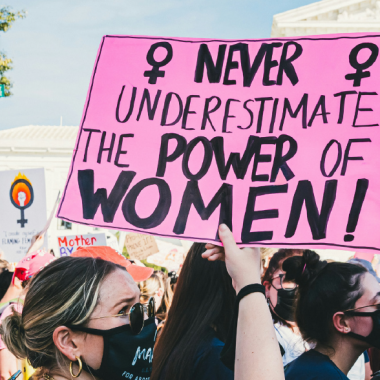‘The history of war is also the history of the media’: at dawn on Saturday 7 October 2023, Hamas fighters launched Operation Flood of Al-Aqsa against Israel. From the very first hours, the attack was widely echoed on social networks. #According to Visibrain, with more than 170 million messages on X (formerly Twitter) linked to the attack and the response that followed, the war between Hamas and Israel even surpassed the number of messages circulated at the start of the Covid-19 pandemic. Between fake news, propaganda and a lack of moderation, social networks are fast becoming a communication warground for the belligerents.
Social networks, a sounding board for a war of images and one-upmanship
From the start of the attack, social networks were flooded with photos and videos of Hamas’s actions: the video of a young woman stripped naked and unconscious in the back of a pick-up truck, the death of a grandmother filmed on Facebook, fighters announcing the death of their loved ones to Israelis over the telephone… In addition to the shocking images, Hamas is also displaying its attacking strength for all to see, with videos showing paragliders taking off to reach southern Israel and a tractor being used as a battering ram to bring down barbed-wire fences. The aim? To increase terror in the Israeli camp and destabilise its army. Well-crafted propaganda that sometimes plays on terror, sometimes on Hamas’s demonstration of strength and organisation, relayed by users. A one-upmanship in the illustration of violence and terror, whose impact on the users of these platforms and the shares that accompany it provides a sounding board for the war communication orchestrated by Hamas.
In response, the Israeli armed forces are sharing videos showing the preparation of the Air Force soldiers, who are numerous and well-equipped, with a view to retaliating. Benjamin Netanyahu is shown alongside the soldiers on the ground. After demonstrations of force, Israel is relying on another type of communication, that of emotion. Counting the number of civilian victims, videos of the population giving blood or of buildings ravaged by flames after rocket explosions… Images collected and broadcast to illustrate the brutality affecting the country and to move people beyond its borders.
While on social networks, Israel communicates mainly on the official accounts of its institutions, Hamas for its part mobilises its television channel Al-Aqsa TV, which is heavily mobilised by Hamas to relay the statements of its representatives and broadcast them to as many people as possible in the digital space.
Sequences hijacked, falsified or even taken from fiction. As if the horror were not enough, many accounts take advantage of the opportunity to spread fake news in order to destabilise their opponents and sway public opinion: videos of Hamas fighters breaking into Israeli territory by paraglider (actually filmed in Egypt in September 2023 at the Cairo military academy); a cloud of rockets fired by Hamas towards Israel (video of the war in Syria shared on social networks from February 2020); or Israeli helicopters shot down in mid-air by members of Hamas (extract taken from the video game Arma III). … hijacked footage shared thousands of times by users with the aim of discrediting the adversary or establishing the dominance of one of the two camps.
URGENTE 🇵🇸 Palestina🇵🇸 Soldados do Hamas com parapentes invadem os territórios ocupados por Israel na Faixa de Gaza. pic.twitter.com/y31rSOmggE
— w2a news (@w2anews) October 10, 2023
The journalists denounce the responsibility of the algorithms that bring up shocking content with the aim of keeping users on the platform as long as possible, whether or not the content has been verified, and that direct the publications that appear in users’ news feeds according to their convictions, thus providing them with no neutral information.
Where does this fake news come from? According to journalist Samira El Gadir, the content comes from Russian or Iranian accounts close to Hamas, ultra- and far-right European accounts aimed at equating Muslims with terrorists, and conspiracy theorists.
Launched around 13 October by the American far right and also relayed by the conspiracy movement, the #BibiKnew (Bibi being Benyamin Netanyahu’s nickname) implies that the Israeli Prime Minister ‘knew’ and even that he organised these attacks because of the public protests linked to his reform of the justice system, which have been taking place in the country for the past year.
If conspiracy theorists and the ultra-right were not enough to propagate fake news, certain political figures are also relaying these falsehoods. The day after the attack, Ashlea Simon, chairwoman of the far-right British party Britain First, shared a video on Twitter showing children being locked in cages by Hamas. Relayed thousands of times on social networks, the video was actually posted on TikTok several days before the attack and showed children playing at school. Despite a warning from users and a message from Twitter stating that the video had been taken out of context, the politician did not delete her publication.

The rumour of beheaded newborn babies quickly spread across the web, following a report by the Israeli channel i24 News and statements by Joe Biden in support of his claims. In the end, the White House spokesman backtracked and said that the President of the United States had never consulted these photos. Accounts close to Hamas did not miss this backtracking and accused Israel of lying and manipulating public opinion to rally it to its cause. On Twitter, the official account of the Israeli Prime Minister’s office then published the images of children’s bodies, which it claimed were authenticated as being those of the Kfar Aza kibbutz massacre. Several pro-Hamas accounts, including the Hamas news agency, are using the Optic Ai Or Not software, which is supposed to detect signs of AI generation, and are accusing Israel of generating fake images of burnt babies, backed up by screenshots of the software itself. So several user accounts and even journalists produced counter-tests on the Optic Ai Or Not software, the results of which varied considerably. Information confirmed by the software spokesperson himself to deny these accusations.
The new media are not to be outdone: several journalists are also warning about independent news accounts that are sometimes biased. Gathering communities of thousands of subscribers, such as CerfiaFR, L_ThinkTank or AlertesInfos, these ‘real-time information’ accounts, often from unreliable sources, do so without any real journalistic work and, above all, without any verification of the information shared. These ‘new media’, whose publications sometimes garner millions of impressions and are shared en masse by users, then represent an ideal sounding board for informational propaganda.
Communication strategies: taking public opinion as a witness and mobilising popular influencers
These communication strategies, which use a variety of means, all have the same objective: to gain the upper hand over the adversary through public opinion.
The use of communication codes, although similar to propaganda actions encountered in any war context, may come as a surprise. All the modern codes of communication are used, like the press agency linked to Hamas, Quds News Network, which publishes videos that use, for example, the codes of ‘fact-checking’ and ‘debunking’ techniques to deconstruct the adversary’s discourse.
From the “beheaded babies” story to the “raped women” and the AI generated “proofs”.
How does #Israel manufacture lies and how does its baseless propaganda spread in major media outlets and go unchecked?
Journalist @MunaHawwa has the answers. #Palestine #Israel pic.twitter.com/gC4NBhDDzz— Quds News Network (@QudsNen) October 13, 2023
In Israel, the actors in the Israeli series ‘Fauda’, popularised around the world thanks to the Netflix platform, have taken up the codes of e-influence and are sharing various videos, sometimes thanking world public opinion for its support for Israel, sometimes bearing witness to the reality of the fighting taking place. Wearing a soldier’s uniform, Idan Amedi, one of the actors in the series, says in a face-to-face video: ‘This is not a scene from Fauda, this is real life’. In a video relayed on Twitter by the official account of the Israeli embassy in France, Itzik Cohen, a second actor in Fauda, spoke in Arabic and then in English, explaining that he had heard a lot of fake news since the Hamas attack and declaring that ‘Hamas fighters are not fighting for freedom [for the Palestinian people], they are terrorists who want to destroy Israel and kill Jews around the world. (…) I know that these atrocities seem unimaginable, but these are the facts’ and asks users not to spread this fake news. The video that had the greatest impact, and which was the subject of several articles in the French press, was that of the lead actor in the same Fauda series, Lior Raz. A veteran of an elite Israeli combat unit before moving into cinema, the actor shares a video of himself in the middle of a rescue operation as rockets explode a few metres from him, and explains how he extracted two families from the bombed-out town in the south of the country. Between pride and unity, in these videos, the actors convey the same message: ‘we are mobilised, just like you, for our country’.
« Ces derniers jours, j’ai entendu énormément d’informations mensongères (…) ces événements atroces sont pourtant réels » | Itzik Cohen, alias Captain Ayub dans @FaudaOfficial, a un message à vous faire passer 🇮🇱⤵️ pic.twitter.com/aE03hmPOZy
— Ambassade d’Israël en France (@IsraelenFrance) October 15, 2023
Accompanied by Yohanan Plesner @yplesner and Avi @issacharoff , I headed down south to join hundreds of brave “brothers in arms” volunteers who worked tirelessly to assist the population in the south of Israel. We were sent to the bombarded town of Sderot to extract 2 families pic.twitter.com/WpM9JLeOZM
— Lior Raz (@lioraz) October 9, 2023
While advertising in the context of war is nothing new, today the purchase of online advertising space used for propaganda before the launch of a YouTube video or during a game of Candy Crush is even more surprising. On Thursday 12 October, a number of users complained about an anxiety-inducing advertisement broadcast online. A 27-second video in pastel shades, showing unicorns amidst rainbows and smiling stars, with the following message: ‘We know your child can’t read this. We have an important message for you as a parent. 40 babies have been murdered in Israel by Hamas (ISIS) terrorists. Just as you would do anything for your child, we will do anything to protect ours. Now, hold your baby in your arms and stand by our side’. At the end of the video appears the logo of the Israeli Ministry of Foreign Affairs. Despite a number of reports, the advert is in order according to Google – which nevertheless banned it from being broadcast on YouTube Kids because of its ‘political nature and references to death’.
The codes of modern communication are used for the same purpose: to convince through emotion, to illustrate the atrocities in Gaza and Israel in order to rally support for one’s cause, to highlight the flaws of one’s opponent in order to win over public opinion and finally to emerge victorious.
Moderation at half-mast: are platforms failing in their responsibility to protect users?
Between violent content and disinformation, social networks have become the ideal playground in times of war. What about moderation? The European Union has been quick to call platforms to order regarding their moderation obligations under the new European legislation on digital services (DSA), which came into force at the end of August. While Meta said it was setting up a special operations centre staffed by experts to monitor developments closely in real time, TikTok said it was setting up ‘a command centre’ and had decided to upgrade its ‘real-time proactive automated detection systems’ aimed at automatically detecting and deleting graphic and violent content without exposing users or their moderators to it.
What about X? Since its takeover by Elon Musk, the social network had already been in the sights of European Commissioner Thierry Breton, who announced that the platform was currently under investigation for ‘alleged dissemination of false information, violent and terrorist content and hate speech’. Is this the result of the dismissal of part of the moderation team? Or the fact that Twitter Blue’s paid-for certification legitimises the speech of unverified accounts?
Above all, this war reveals an extremely dangerous crisis in information, and more specifically in disinformation. In the age of social networks, the speed at which information spreads, algorithms, artificial intelligence, foreign-influenced accounts… how can we get accurate information in wartime? Who can we trust?
The coverage of the explosion at the Al-Ahli Arabi hospital is a perfect illustration of this question.










